Teumer, Alfred, born on 01-02-1918 in Neustadt am Rübenberge, 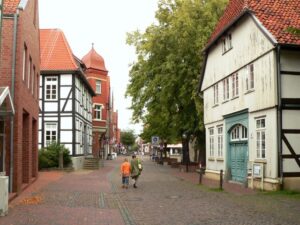 grew up in the Weimar Republic and Nazi Germany.
grew up in the Weimar Republic and Nazi Germany.
Following completion of flight and fighter pilot training, Alfred was posted to 3. Staffel (3rd squadron) of Jagdgeschwader 54 (JG 54—54th Fighter Wing)  under command of Oberst Otto Hans “Hannes” Trautloft
under command of Oberst Otto Hans “Hannes” Trautloft  on 02-12-1941 during the final days of Operation Barbarossa
on 02-12-1941 during the final days of Operation Barbarossa  , the attack on Russia, holding the rank of Leutnant. At the time, 3. Staffel was temporarily commanded by Oberleutnant Max-Hellmuth Ostermann,
, the attack on Russia, holding the rank of Leutnant. At the time, 3. Staffel was temporarily commanded by Oberleutnant Max-Hellmuth Ostermann, 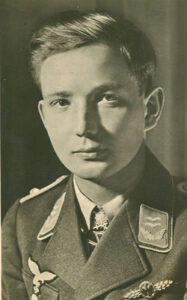 who was substituting for Oberleutnant Hans Schmoller-Haldy.
who was substituting for Oberleutnant Hans Schmoller-Haldy. 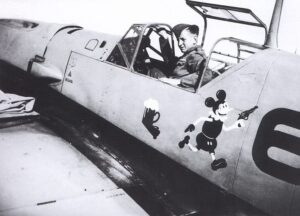 Ostermann died 09-08-1942, at age 24, in aerial combat with Soviet fighters in near Lake Ilmen, Leningrad Oblast, Soviet Union.
Ostermann died 09-08-1942, at age 24, in aerial combat with Soviet fighters in near Lake Ilmen, Leningrad Oblast, Soviet Union.
The Staffel was subordinated to Gruppe (1st group) of JG 54 headed by Hauptmann Erich von Selle 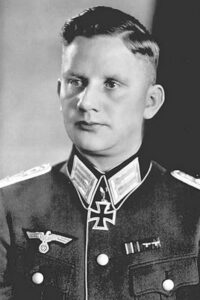 and was based at Krasnogvardeysk, present-day Gatchina. The Gruppe fought in the northern sector of the Eastern Front in the aerial battles of the Siege of Leningrad. Hauptman von Selle died on 01-02-1945, age 37, as battalion commander near Frauenburg in the Courland Pocket.Teumer was appointed Staffelkapitän (squadron leader) of 5. Staffel (5th squadron)
and was based at Krasnogvardeysk, present-day Gatchina. The Gruppe fought in the northern sector of the Eastern Front in the aerial battles of the Siege of Leningrad. Hauptman von Selle died on 01-02-1945, age 37, as battalion commander near Frauenburg in the Courland Pocket.Teumer was appointed Staffelkapitän (squadron leader) of 5. Staffel (5th squadron) 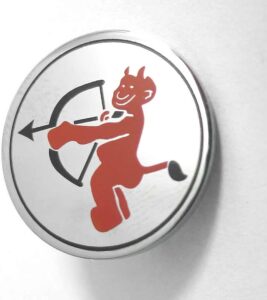 of JG 54 in April 1943. Alfred then commanded the newly created 10. Staffel of JG 54 before he was wounded in combat on 03-09-1943.
of JG 54 in April 1943. Alfred then commanded the newly created 10. Staffel of JG 54 before he was wounded in combat on 03-09-1943. 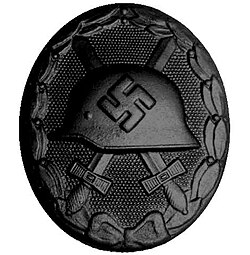 Following his recovery, he was given command of 2. Staffel of JG 54 in December 1943. In April 1944, Teumer was transferred to 7. Staffel of JG 54 which was fighting in Defense of the Reich on the Western Front. On 19-08-1944, Teumer was awarded the Knight’s Cross of the Iron Cross
Following his recovery, he was given command of 2. Staffel of JG 54 in December 1943. In April 1944, Teumer was transferred to 7. Staffel of JG 54 which was fighting in Defense of the Reich on the Western Front. On 19-08-1944, Teumer was awarded the Knight’s Cross of the Iron Cross ![]() for 76 aerial victories claimed. He was then transferred to Kommando Nowotny, Walter “Nowi” or “Tiger of Wolchowstroj”
for 76 aerial victories claimed. He was then transferred to Kommando Nowotny, Walter “Nowi” or “Tiger of Wolchowstroj” 
 an experimental unit flying the Messerschmitt Me 262 jet fighter.
an experimental unit flying the Messerschmitt Me 262 jet fighter. 
On 28-12-1941, I. Gruppe flew combat air patrols along the Volkhov where German ground forces were retreating fighting against the Volkhov Front. During these missions, Teumer claimed his first aerial victory when he shot down a Petlyakov Pe-2 bomber. 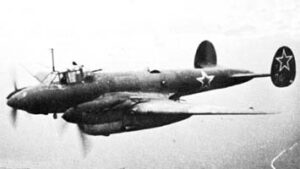 On 05-02-1942, command of I. Gruppe was given to Hauptmann Franz Eckerle
On 05-02-1942, command of I. Gruppe was given to Hauptmann Franz Eckerle 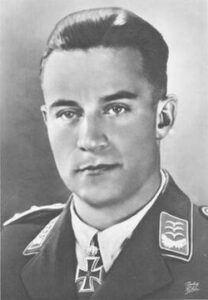 when Selle was transferred. Teumer claimed his second aerial victory on 9 January over a I-26 fighter, an early war German designation for the Yakovlev Yak-1. That day, the Gruppe again flew missions in support of the army along the Volkhov in the combat area southeast of Leningrad near Tosno. Two days later, flying over the same combat area, Teumer was credited with two I-18 fighters shot down, a reference to the Mikoyan-Gurevich MiG-1 fighter aircraft. The Mikoyan-Gurevich MiG-1
when Selle was transferred. Teumer claimed his second aerial victory on 9 January over a I-26 fighter, an early war German designation for the Yakovlev Yak-1. That day, the Gruppe again flew missions in support of the army along the Volkhov in the combat area southeast of Leningrad near Tosno. Two days later, flying over the same combat area, Teumer was credited with two I-18 fighters shot down, a reference to the Mikoyan-Gurevich MiG-1 fighter aircraft. The Mikoyan-Gurevich MiG-1  was a Soviet fighter aircraft of World War II that was designed to meet a requirement for a high-altitude fighter issued in 1939. To minimize demand on strategic materials such as aluminum, the aircraft was mostly constructed from steel tubing and wood. The fighting along the Volkhov continued in the second half of January, predominately in the area between Leningrad and Shlisselburg. On 26 January, Teumer claimed his fifth aerial victory when he shot down a Pe-2 bomber. Then on 30 January, Teumer made an emergency landing in his Messerschmitt Bf 109 F-2 at Chudovo, damaging the aircraft to 40%. On 14 February, Eckerle was killed in action on 14-02-1942, age 29, (missing after airbattle) and command of I. Gruppe went to Hauptmann Hans “Fips” Philipp.
was a Soviet fighter aircraft of World War II that was designed to meet a requirement for a high-altitude fighter issued in 1939. To minimize demand on strategic materials such as aluminum, the aircraft was mostly constructed from steel tubing and wood. The fighting along the Volkhov continued in the second half of January, predominately in the area between Leningrad and Shlisselburg. On 26 January, Teumer claimed his fifth aerial victory when he shot down a Pe-2 bomber. Then on 30 January, Teumer made an emergency landing in his Messerschmitt Bf 109 F-2 at Chudovo, damaging the aircraft to 40%. On 14 February, Eckerle was killed in action on 14-02-1942, age 29, (missing after airbattle) and command of I. Gruppe went to Hauptmann Hans “Fips” Philipp. 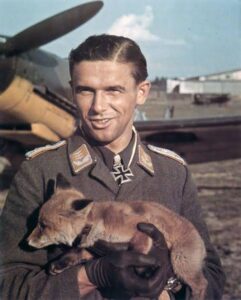 In early March, the Gruppe supported the German 18th Army which was fighting in the Battle of Lyuban. In these battles, Teumer claimed a Curtiss P-40 Warhawk fighter on 5 March. The next day, he was credited with another P-40 fighter and an I-18 fighter shot down.
In early March, the Gruppe supported the German 18th Army which was fighting in the Battle of Lyuban. In these battles, Teumer claimed a Curtiss P-40 Warhawk fighter on 5 March. The next day, he was credited with another P-40 fighter and an I-18 fighter shot down.
On 09-02-1943, Teumer’s Bf 109 G-2 was hit by anti-aircraft artillery and suffered engine failure, resulting in a forced landing at Sologubowka, approximately 70 kilometers (43 miles) southeast of Saint Petersburg. Teumer was appointed Staffelkapitän (squadron leader) of 5. Staffel of JG 54 in April 1943. He replaced Hauptmann Peter Paul Steindl 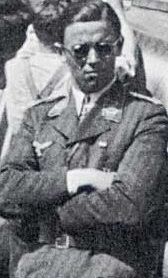 who was transferred. Hauptman Steidl on 09-01-45, age 30, crashed during a test flight On 20 June, the creation of a newly formed IV. Gruppe (4th group) of JG 54 was ordered. Its first commander was Hauptmann Erich Rudorffer.
who was transferred. Hauptman Steidl on 09-01-45, age 30, crashed during a test flight On 20 June, the creation of a newly formed IV. Gruppe (4th group) of JG 54 was ordered. Its first commander was Hauptmann Erich Rudorffer. 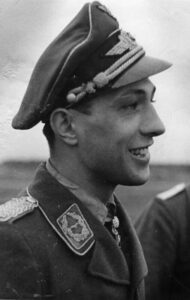 Rudorffer survived the war and became a flight instructor in the modern German air force. He, nickname “Fighter of Libau” passed away in Bad Schwartau, on 08-04-2016, age 98.
Rudorffer survived the war and became a flight instructor in the modern German air force. He, nickname “Fighter of Libau” passed away in Bad Schwartau, on 08-04-2016, age 98.
Teumer was tasked with the creation of 10. Staffel in July, a squadron of IV. Gruppe. On 3 September, he was wounded 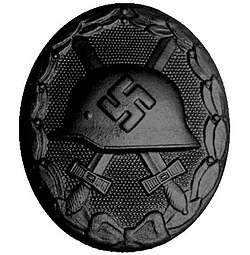 in aerial combat flying a Bf 109 G-6 northwest of Gatchina. He was replaced Oberleutnant Robert “Bazi” Weiß
in aerial combat flying a Bf 109 G-6 northwest of Gatchina. He was replaced Oberleutnant Robert “Bazi” Weiß  as commander of 10. Staffel. During his convalescence, Teumer was awarded the German Cross in Gold (Deutsches Kreuz in Gold)
as commander of 10. Staffel. During his convalescence, Teumer was awarded the German Cross in Gold (Deutsches Kreuz in Gold)  on 17 October. Bazi Weiss Weiß, age 24, was one of the pilots killed, as he was shot down in his Fw 190 D-9 “Black 10” near Lengerich. After his recovery, Alfred took command of 2. Staffel of JG 54 from Oberleutnant Otto Vinzent
on 17 October. Bazi Weiss Weiß, age 24, was one of the pilots killed, as he was shot down in his Fw 190 D-9 “Black 10” near Lengerich. After his recovery, Alfred took command of 2. Staffel of JG 54 from Oberleutnant Otto Vinzent  in December 1943. On 14 February, I. Gruppe moved to an airfield named Wesenberg near Rakvere, located approximately 60 kilometers (37 miles) north of Lake Peipus and 105 kilometers (65 miles) west of Narva. Here the Gruppe was subordinated to the 3. Flieger-Division (3rd Air Division)
in December 1943. On 14 February, I. Gruppe moved to an airfield named Wesenberg near Rakvere, located approximately 60 kilometers (37 miles) north of Lake Peipus and 105 kilometers (65 miles) west of Narva. Here the Gruppe was subordinated to the 3. Flieger-Division (3rd Air Division) 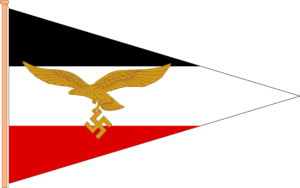 and fought in the Battle of Narva.
and fought in the Battle of Narva.
In April 1944, Teumer was transferred to 7. Staffel of JG 54. He took command of the Staffel from Oberleutnant Rudolf Klemm who had been wounded in aerial combat on 9 April. After being wounded, he was blind in one eye.


 Rudolf Klemm survived the war and passed away, age 78 on 05-07-1989.
Rudolf Klemm survived the war and passed away, age 78 on 05-07-1989.
The Staffel was subordinated to III. Gruppe led by Major Werner Schröer. 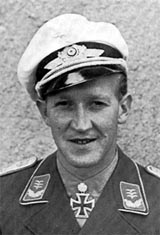
 At the time, the Gruppe was based at Lüneburg Airfield and subordinated to 2. Jagd-Division (2nd Fighter Division)
At the time, the Gruppe was based at Lüneburg Airfield and subordinated to 2. Jagd-Division (2nd Fighter Division) 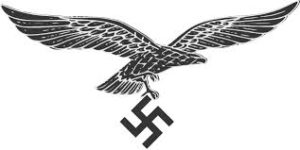 fighting in Defence of the Reich. On 20 April, III. Gruppe relocated to Landau an der Isar for conversion training to the Focke-Wulf Fw 190. In consequence of this relocation, the Gruppe came under the control of 7. Jagd-Division (7th Fighter Division). Conversion training was relatively short and the Gruppe flew its first mission on the Fw 190 against attacking United States Army Air Forces (USAAF) heavy bombers on 19 May. That day, Teumer was credited with an Herausschuss (separation shot)—a severely damaged heavy bomber forced to separate from its combat box which was counted as an aerial victory—over a Consolidated B-24 Liberator bomber.
fighting in Defence of the Reich. On 20 April, III. Gruppe relocated to Landau an der Isar for conversion training to the Focke-Wulf Fw 190. In consequence of this relocation, the Gruppe came under the control of 7. Jagd-Division (7th Fighter Division). Conversion training was relatively short and the Gruppe flew its first mission on the Fw 190 against attacking United States Army Air Forces (USAAF) heavy bombers on 19 May. That day, Teumer was credited with an Herausschuss (separation shot)—a severely damaged heavy bomber forced to separate from its combat box which was counted as an aerial victory—over a Consolidated B-24 Liberator bomber. 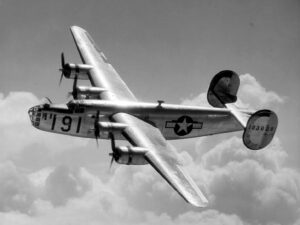 The Gruppe flew further missions on 22, 24, 25, 27, 28 and 29 May. On 24 May, Teumer was credited with shooting down a Boeing B-17 Flying Fortress bomber followed by another Herausschuss over a B-17 bomber on 27 May.
The Gruppe flew further missions on 22, 24, 25, 27, 28 and 29 May. On 24 May, Teumer was credited with shooting down a Boeing B-17 Flying Fortress bomber followed by another Herausschuss over a B-17 bomber on 27 May.
When Allied forces launched Operation Overlord, the invasion of German-occupied Western Europe on 6 June, III. Gruppe was immediately ordered to relocate to Villacoublay Airfield. That day, the Gruppe reached Nancy, arriving in Villacoublay the following day where it was subordinated to II. Fliegerkorps (2nd Air Corps). Its primary objective was to fly fighter-bomber 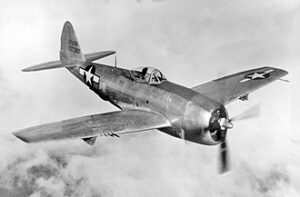 missions in support of the German ground forces. The Gruppe flew its first missions on 7 June to the combat area east of Caen and the Orne estuary. Teumer claimed his first aerial victory in this combat area on 8 June when he shot down a USAAF North American P-51 Mustang fighter. Two days later, he was shot down in aerial combat near the Orne estuary. He managed to bail out of his Fw 190 A-8 ZY but was wounded in the encounter. In July, the Gruppe supported the German forces fighting in the Battle of Saint-Lô and the combat area near Paris predominantly under the control of Jagdgeschwader 26 “Schlageter” (JG 26—26th Fighter Wing).
missions in support of the German ground forces. The Gruppe flew its first missions on 7 June to the combat area east of Caen and the Orne estuary. Teumer claimed his first aerial victory in this combat area on 8 June when he shot down a USAAF North American P-51 Mustang fighter. Two days later, he was shot down in aerial combat near the Orne estuary. He managed to bail out of his Fw 190 A-8 ZY but was wounded in the encounter. In July, the Gruppe supported the German forces fighting in the Battle of Saint-Lô and the combat area near Paris predominantly under the control of Jagdgeschwader 26 “Schlageter” (JG 26—26th Fighter Wing). ![]() In these battles, Teumer claimed a Lockheed P-38 Lightning fighter on 26 July, 1944. In early August, combat shifted to Avranches, Mortain and Falaise. On 8 and 9 August, Teumer was credited with two further P-38 fighters shot down, one on each of these dates.
In these battles, Teumer claimed a Lockheed P-38 Lightning fighter on 26 July, 1944. In early August, combat shifted to Avranches, Mortain and Falaise. On 8 and 9 August, Teumer was credited with two further P-38 fighters shot down, one on each of these dates.
On 16 August, III. Gruppe was withdrawn from the front and sent to München Gladbach, present-day Mönchengladbach, for a period of rest and replenishment. There, Teumer was awarded the Knight’s Cross of the Iron Cross (Ritterkreuz des Eisernen Kreuzes) ![]() on 19-08-1944 for 76 aerial victories claimed. During this period, Teumer served as acting Gruppenkommandeur (group commander) of III. Gruppe until 17 September. Teumer, who was childhood friend of Hauptman Martin Drewes,
on 19-08-1944 for 76 aerial victories claimed. During this period, Teumer served as acting Gruppenkommandeur (group commander) of III. Gruppe until 17 September. Teumer, who was childhood friend of Hauptman Martin Drewes, 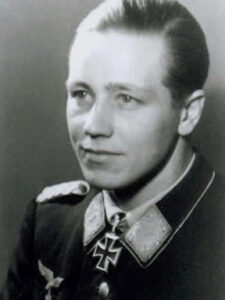
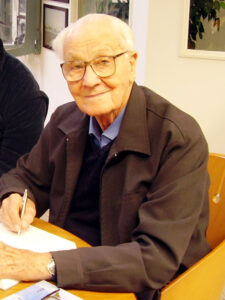 took command of 2. Staffel of Kommando Nowotny, flying the Messerschmitt Me 262 jet fighter.
took command of 2. Staffel of Kommando Nowotny, flying the Messerschmitt Me 262 jet fighter.
Hauptman Drewes survived the war and passed away on 13-10-2013 in Blumenau, Santa Catarina, southern Brazil, of natural causes.
Death and burial ground of Teumer, Alfred.
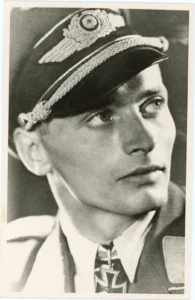 The unit was named after Major Walter “Tiger of Wolchowstroj” Nowotny
The unit was named after Major Walter “Tiger of Wolchowstroj” Nowotny  and was tasked with testing the Me 262 under operational conditions. Teumer, who had received some training on the Me 262 at Rechlin, was killed in a flying accident on 04-10-1944, aged 26, in Hesepe near Osnabrückat Hesepe airfield. His Me 262 A-1a had suffered engine failure during the landing approach. Alfred is buried at Bramsche ev.Friedhof St.Martin, Bad Iburg, Landkreis Osnabrück, Lower Saxony, Germany.
and was tasked with testing the Me 262 under operational conditions. Teumer, who had received some training on the Me 262 at Rechlin, was killed in a flying accident on 04-10-1944, aged 26, in Hesepe near Osnabrückat Hesepe airfield. His Me 262 A-1a had suffered engine failure during the landing approach. Alfred is buried at Bramsche ev.Friedhof St.Martin, Bad Iburg, Landkreis Osnabrück, Lower Saxony, Germany.
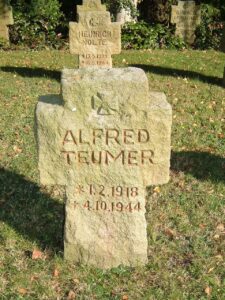
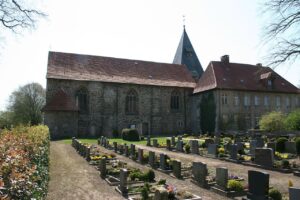





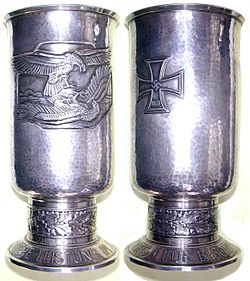












Leave a Reply